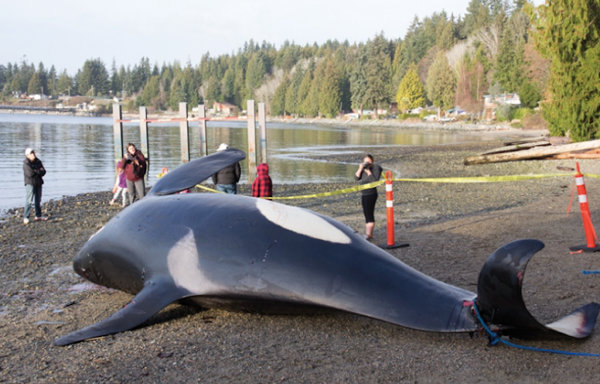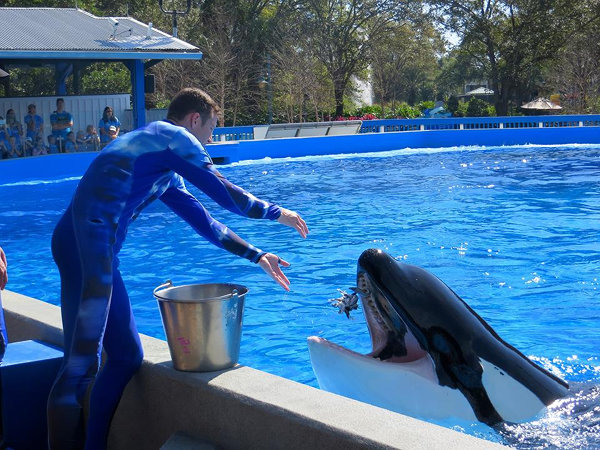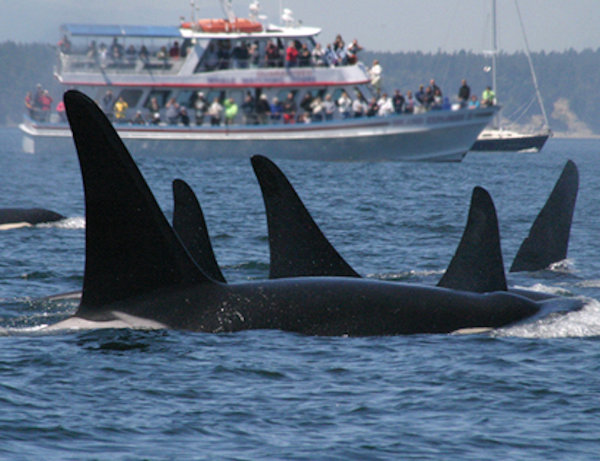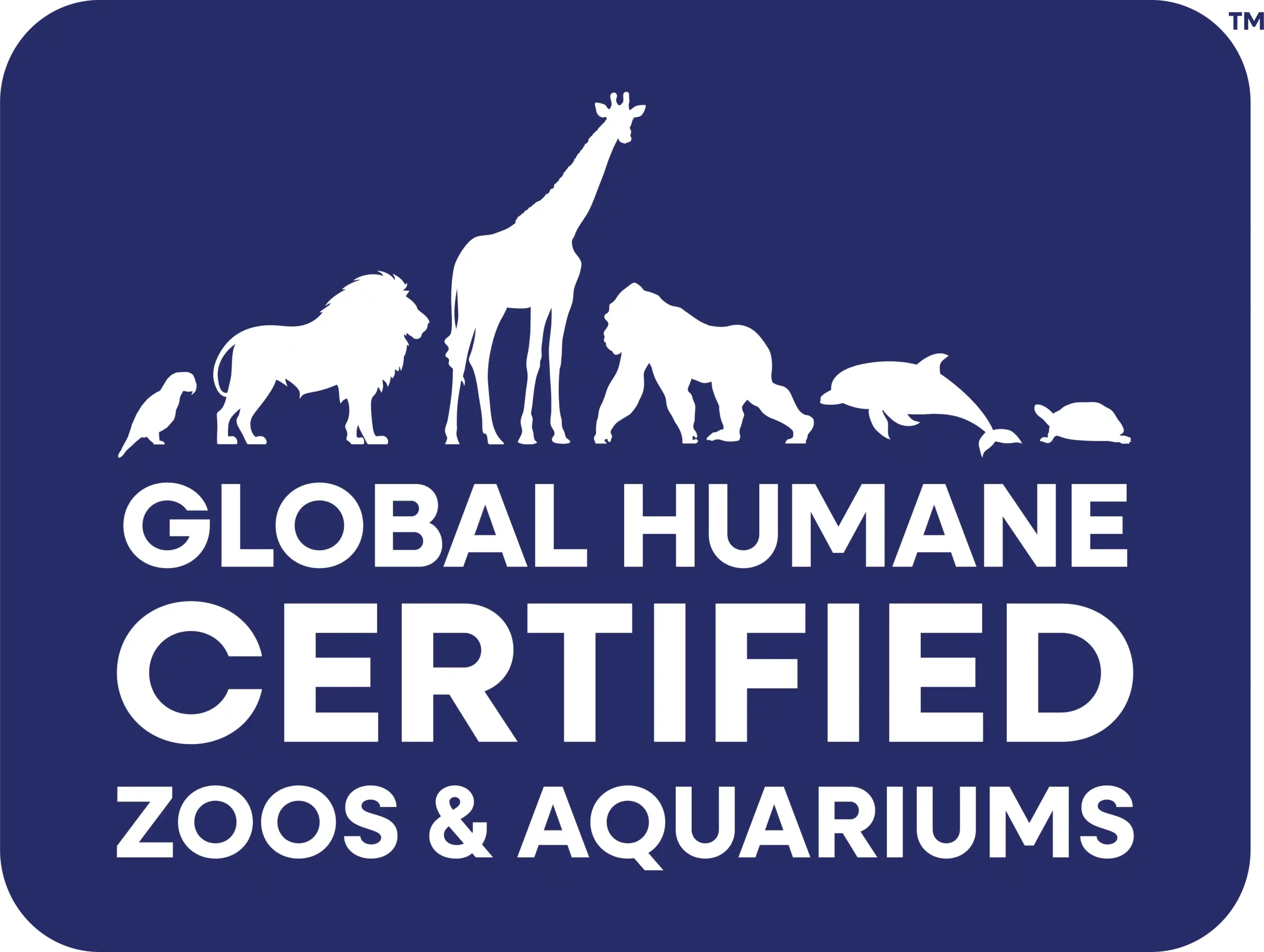Source: Tilikum vs J34 a tale of two killer whales

Deceased J34 – image via CBC
In 2016, the number of Southern Residents plummeted from 83 to 78, one of the smallest populations since record keeping on the whales began in the early 1970s. One of these whales, J-34, or “Doublestuf,” a well known member of the J-22 matriline, washed ashore in British Columbia on December 20th, 2016. A breeding age male of 18, the BC Ministry of Agriculture’s initial examination revealed blunt force trauma and a hematoma as the cause of death. There is a high probability, though unconfirmed, that J-34’s injuries were caused through a vessel strike

People examine J34’s corpse – image via CBC
In other words, J-34 was struck violently on the head, and continued to live for up to a few days, before succumbing to his injuries and dying, most likely alone, in the waters of the Pacific Northwest.

Photo by Erin McKinney
In another part of the country, 3 weeks after J-34’s body washed ashore, another well known male killer whale died. At age 36, after years of veterinary and behavioral support for a complicated chronic infection, SeaWorld Orlando’s Tilikum passed away quietly, in the early hours of January 6th, 2017. He was in the company of the trainers and killer whales he’d known for much of his life since his move to SeaWorld in 1992.
Tilikum was well past the average life expectancy (30) listed by the NOAA for a male killer whale. He had been ill, and supported medically, for years, with an infection found in both free-ranging and zoological animals. His death was not violent or shocking, yet it garnered exponentially more news coverage and discussion then the fate of J-34.
Why? Where were the so-called “animal rights” crusaders, so abundant on Twitter and Facebook, when J-34 was suffering? Why is the death of a geriatric, professionally cared for animal a national ignition point, but the slow and steady destruction of a group of wild whales a special interest story?

Tourist disrupting the natural habitat of Killer Whales – image via NOAA
By all logic it should be reversed: J-34 was the 4th death (out of 6 adults and 3 neonate calves) for the embattled Southern Residents this year. His passing was violent, likely caused by human interference and marked the removal of another breeding animal from a population where the survival rate to 1 year for a calf is less than 50%. But animal rights activism, from PETA to The DoDo and beyond, is big business, and it’s a lot easier to sell ethics if you have a shiny corporation like SeaWorld to demonize.
While leveraging Tilikum’s death might do a lot for Ingrid Newkirk’s bottom line, addressing the death of J-34 means confronting a complicated and uncomfortable fact: humanity is failing the Southern Resident Killer whales. Their numbers are dropping. They’re listed as an endangered species. Over 50% of pregnancies are miscarried, and 43% of calves are lost in the first 6 months of life. They are some of the most contaminated animals on the planet, with nauseating levels of toxins building up in their blubber supply. Their supply of Chinook salmon, their primary food source, is being rapidly depleted. The negative impact of vessels, including whale watching boats, is becoming more and more apparent. All of these factors have been confirmed again and again by federal and NGOs seeking to help the whales recover.
And yet, with the overwhelming information that the Southern Residents are crying out for help, it is Tilikum who makes the headline, SeaWorld who catches the outrage and moral grandstanding, all while Justin Trudeau’s federal Canadian government approves a tar sand pipline project through the primary habitat of the Southern Residents that may turn out to be the death warrant for one of the most well known and well studied killer whale populations on the planet.

Tourists disrupting natural killer whale behaviors in the wild. – Image via WhaleResearch.com
There is no time left for British Columbia’s whales. They are dying, and every time the public is told that attacking SeaWorld is how to help orcas, their chances of recovery grow even slimmer. On December 31st, 2016, “Granny,” the J-pod matriarch, was announced missing, and presumed dead, the most recent in 2016’s alarming Southern Resident fatalities. Even that wasn’t enough to draw the spotlight toward the silently vanishing whales.
There is no true “wild.” Everywhere is marred by humanity’s impact. We must make a decision as a society to turn the tables for the wild whales. We must decide what dies with J-34: either a romanticized and outdated vision of the ocean, or the Southern Resident whales themselves.
Works Cited:
- http://crosscut.com/2017/01/brutal-year-sets-back-orca-recovery/
- http://www.whaleresearch.com/single-post/2017/01/05/Goodbye-Granny
- http://whalemuseum.org/collections/meet-the-whales
- http://www.pac.dfo-mpo.gc.ca/fm-gp/species-especes/mammals-mammiferes/srkw-eprs-j34-eng.html
- http://www.whaleresearch.com/j2
- https://www.nwfsc.noaa.gov/news/features/killer_whale_report/pdfs/bigreport62514.pdf
- http://www.whaleresearch.com/j28
- http://www.nmfs.noaa.gov/pr/species/mammals/whales/killer-whale.html
- https://seaworldcares.com/tilikum












